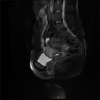Advanced abdominal pregnancy: an increasingly challenging clinical concern for obstetricians
- PMID: 25337188
- PMCID: PMC4203159
Advanced abdominal pregnancy: an increasingly challenging clinical concern for obstetricians
Abstract
Advanced abdominal pregnancy is rare. The low incidence, high misdiagnosis rate, and lack of specific clinical signs and symptoms explain the fact that there are no standard diagnostic and treatment options available for advanced abdominal pregnancy. We managed a case of abdominal pregnancy in a woman who was pregnant for the first time. This case was further complicated by a concurrent singleton intrauterine pregnancy; the twin pregnancy was not detected until 20 weeks of pregnancy. The case was confirmed at 26 weeks gestational age using MRI to be an abdominal combined with intrauterine pregnancy. The pregnancy was terminated by cesarean section at 33 + 5 weeks gestation. We collected the relevant data of the case while reviewing the advanced abdominal pregnancy-related English literature in the Pubmed, Proquest, and OVID databases. We compared and analyzed the pregnancy history, gestational age when the diagnosis was confirmed, the placental colonization position, the course of treatment and surgical processes, related concurrency rate, post-operative drug treatment programs, and follow-up results with the expectation to provide guidance for other physicians who might encounter similar cases.
Keywords: Advanced abdominal pregnancy; clinical; obstetricians.
Figures







Similar articles
-
Fetal MRI in the pre-operative diagnosis and assessment of secondary abdominal pregnancy: a rare sequela of a previous caesarean section.Diagn Interv Radiol. 2012 Sep-Oct;18(5):496-502. doi: 10.4261/1305-3825.DIR.5200-11.1. Epub 2012 Jan 24. Diagn Interv Radiol. 2012. PMID: 22274996
-
Role of serial MRI assessment in the management of an abdominal pregnancy.BMJ Case Rep. 2013 Oct 14;2013:bcr2013200495. doi: 10.1136/bcr-2013-200495. BMJ Case Rep. 2013. PMID: 24127374 Free PMC article.
-
A case of advanced viable extrauterine pregnancy.P N G Med J. 1997 Mar;40(1):44-7. P N G Med J. 1997. PMID: 10365569
-
Full-term abdominal pregnancy: a case report and review of the literature.Gynecol Obstet Invest. 2008;65(2):139-41. doi: 10.1159/000110015. Epub 2007 Oct 22. Gynecol Obstet Invest. 2008. PMID: 17957101 Review.
-
Ultrasound in twin pregnancies.J Obstet Gynaecol Can. 2011 Jun;33(6):643-656. doi: 10.1016/S1701-2163(16)34916-7. J Obstet Gynaecol Can. 2011. PMID: 21846456 Review.
Cited by
-
Challenging Diagnosis of Late Abdominal Pregnancy: A Case Study of Misdiagnosis and Fetal Death in the Third Trimester.Am J Case Rep. 2024 Jul 9;25:e943625. doi: 10.12659/AJCR.943625. Am J Case Rep. 2024. PMID: 38980831 Free PMC article.
-
A case report of an asymptomatic late term abdominal pregnancy with a live birth at 41 weeks of gestation.BMC Res Notes. 2016 Jan 19;9:31. doi: 10.1186/s13104-016-1844-6. BMC Res Notes. 2016. PMID: 26785887 Free PMC article.
-
Right abdominal pregnancy with hemorrhagic shock after previous left tubal pregnancy: A case report.SAGE Open Med Case Rep. 2023 Jun 15;11:2050313X231180757. doi: 10.1177/2050313X231180757. eCollection 2023. SAGE Open Med Case Rep. 2023. PMID: 37359286 Free PMC article.
-
The challenge in the diagnosis and management of an advanced abdominal pregnancy in a resource-low setting: a case report.J Med Case Rep. 2017 Jul 24;11(1):199. doi: 10.1186/s13256-017-1369-1. J Med Case Rep. 2017. PMID: 28735570 Free PMC article.
-
Challenges and perspectives of abdominal pregnancy in a resource-limited setting: A case series.Int J Surg Case Rep. 2024 Feb;115:109282. doi: 10.1016/j.ijscr.2024.109282. Epub 2024 Jan 20. Int J Surg Case Rep. 2024. PMID: 38306869 Free PMC article.
References
-
- Sunday-Adeoye I, Twomey D, Egwuatu EV, Okonta PI. A 30-year review of advanced abdominal pregnancy at the Mater Misericordiae Hospital, Afikpo, southeastern Nigeria (1976-2006) Arch Gynecol Obstet. 2011;283:19–24. - PubMed
-
- Roberts RV, Dickinson JE, Leung Y, Charles AK. Advanced abdominal pregnancy: still an occurrence in modern medicine. Aust N Z J Obstet Gynaecol. 2005;45:518–521. - PubMed
-
- Hyvarinen M, Raudaskoski T, Tekay A, Herva R. [Abdominal pregnancy] . Duodecim. 2009;125:2448–2451. - PubMed
-
- Moonen-Delarue MW, Haest JW. Ectopic pregnancy three times in line of which two advanced abdominal pregnancies. Eur J Obstet Gynecol Reprod Biol. 1996;66:87–88. - PubMed
Publication types
MeSH terms
LinkOut - more resources
Full Text Sources
Medical
